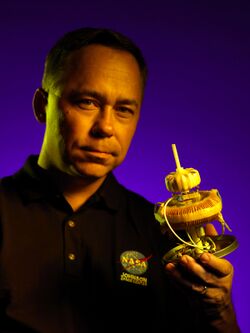
| Version | Summary | Created by | Modification | Content Size | Created at | Operation |
|---|---|---|---|---|---|---|
| 1 | Conner Chen | -- | 575 | 2022-11-16 01:23:57 | | | |
| 2 | Conner Chen | -7 word(s) | 566 | 2022-11-17 05:10:50 | | |
Video Upload Options
1. Introduction
Harold G. "Sonny" White is a mechanical engineer, aerospace engineer and applied physicist who is the Advanced Propulsion Team Lead for the NASA Engineering Directorate and is known for proposing new Alcubierre drive concepts and promoting advanced propulsion projects, under development at the NASA Johnson Space Center, including the first practical experiment to test the existence of Alcubierre drive effects.
2. Educational
White obtained a B.S. degree in mechanical engineering from University of South Alabama, an M.S. degree in mechanical engineering from Wichita State University in 1999,[1] and a Ph.D. degree in Physics from Rice University in 2008.[2][3]
3. Alcubierre "Warp" Drive
White attracted the attention of the press when he began presenting his ideas at space conventions and publishing proposals for Alcubierre drive concepts. In 2011, he released a paper titled Warp Field Mechanics 101 that outlined an updated concept of Miguel Alcubierre's faster-than-light propulsion concept, including methods to prove the feasibility of the project. Alcubierre's concept had been considered infeasible because it required far more power than any viable energy source could produce. White re-calculated the Alcubierre concept and proposed that if the warp bubble around a spacecraft were shaped like a torus, it would be much more energy efficient and make the concept feasible. White has stated that "warp travel" has not yet seen a "Chicago Pile-1" experiment, a reference to the very first nuclear reactor, the breakthrough demonstration that paved the way for nuclear power.[4][5][6]
To investigate the feasibility of a warp drive, White and his team have designed a warp field interferometer test bed to demonstrate warp field phenomena. The experiments are taking place at NASA's Advanced Propulsion Physics Laboratory ("Eagleworks") at the Johnson Space Center.[5] White and his team claim that this modified Michelson interferometer will detect distortion of space-time, a warp field effect.[7]
4. EmDrive
In April 2015, the space enthusiast website NASASpaceFlight.com announced, based on a post on their site's forum by NASA Eagleworks engineer Paul March, that NASA had successfully tested their EM Drive in a hard vacuum – which would be the first time any organization has claimed such a successful test.[8] In November, 2016, Harold White, along with other colleagues at NASA's Eagleworks program published their findings on the proposed EM Drive.[9]
5. Other Works
White and his team are also working on several other "breakthrough space technology" projects, including a new thruster concept, another concept White claims works by utilizing effects predicted by quantum mechanics. To support this research, White's team also is developing a "micro-balance" that is capable of measuring the extremely small forces predicted to be produced by this thruster. To calibrate this balance the team plans to repeat an unsuccessful 2006 Woodward effect experiment, this time using the new micro-balance.[10]
6. Awards
White was awarded the NASA Exceptional Achievement Medal by the Administrator for his role in getting the Thermal Protection System robotic inspection tools during the Space Shuttle's return to flight.[11] White has also received the Silver Snoopy Award for discovery and disposition of critical damage to the robotic arm prior to the Space Shuttle STS-121 mission.[3]
References
- Personnel page - website of the Department of Mechanical Engineering of Wichita State University http://www.engr.wichita.edu/hlankarani/personnel.htm
- Graduate Study Recent Theses - website of the Physics and Astronomy Department of Rice University http://physics.rice.edu/Content.aspx?id=63
- Icarus Interstellar. "Dr. Harold 'Sonny' White" , Project Icarus. http://www.icarusinterstellar.org/team/harold-white/
- Oswald, Ed. "NASA working on faster-than-light space travel, says warp drives are ‘plausible’", ExtremeTech. http://www.extremetech.com/extreme/136408-nasa-working-on-faster-than-light-travel-says-warp-drives-are-plausible
- White, Harold. "Warp Field Mechanics 101", NASA, Houston, TX. https://ntrs.nasa.gov/archive/nasa/casi.ntrs.nasa.gov/20110015936_2011016932.pdf
- A Discussion of Space-Time Metric Engineering - Digital Library for Physics and Astronomy of Harvard University http://adsabs.harvard.edu/abs/2003GReGr..35.2025W
- Dvorsky, George. "How NASA might build its very first warp drive", io9. http://io9.com/5963263/how-nasa-will-build-its-very-first-warp-drive
- http://www.nasaspaceflight.com/2015/04/evaluating-nasas-futuristic-em-drive/ Evaluating NASA’s Futuristic EM Drive
- "Measurement of Impulsive Thrust from a Closed Radio-Frequency Cavity in Vacuum". http://arc.aiaa.org/doi/10.2514/1.B36120. Retrieved 23 November 2016.
- "Eagleworks Laboratories: Advanced Propulsion Physics Research". NASA. 2 December 2011. https://ntrs.nasa.gov/archive/nasa/casi.ntrs.nasa.gov/20110023492_2011024705.pdf. Retrieved 10 January 2013.
- Agency Honor awards https://searchpub.nssc.nasa.gov/servlet/sm.web.Fetch/Agency_Honor_brochure_2006.pdf?rhid=1000&did=1235443&type=released

Location: Harold Sonny White




